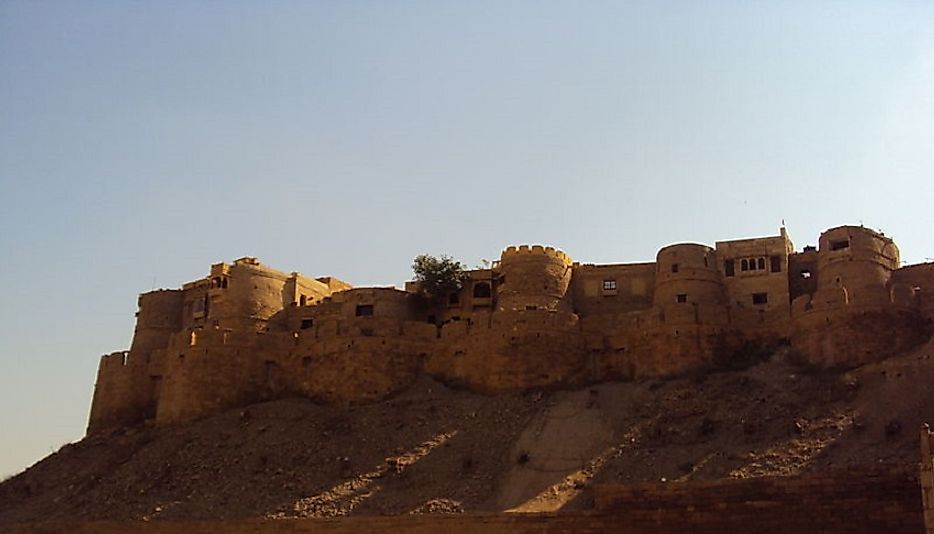Jaisalmer Fort Of Rajasthan, India

5. Description and History
Situated amidst the sandy expanses of the Thar Desert in the Indian state of Rajasthan, the Jaisalmer Fort is a spectacular fortification with a rich history. The fort, made of yellow sandstone, sits atop the Trikuta Hill, well camouflaged in the desert landscape. The Jaisalmer Fort is often popularly referred to as the “Golden Fort” or “Sonar Kella” due to its honey gold-colored appearance at sunset. The fort also enjoys the privilege of being a UNESCO World Heritage Site. The Jaisalmer Fort was built by Rawal Jaisal, a Hindu Rajput ruler, in 1156 CE. The fort witnessed a large number of battles and invasions during its prime years as the Rajput kings attempted to save the fort against annexation by the Muslim rulers of the Delhi Sultanate. Finally, in 1570, the Hindu Rajputs lost control over the fort and were forced to surrender to the Mughal ruler Akbar. At its peak, the Jaisalmer Fort served as an important center of trade between India and Arabic world. During the British rule, the fort’s importance as a trade point declined and maritime trade became more popular. Thus, the fort lost its former glory. However, currently, the fort’s lost splendor has been revived once more, and it now serves as an important tourist destination in India.
4. Tourism
Thousands of tourists touring Rajasthan visit the Jaisalmer Fort each year. The spectacular appearance of the fort, its beautiful Hindu, and ornate Jain temples, and majestic architecture are a treat to all eyes. Tourists visiting this fort also visit such nearby allures as the Patwon-Ki-Haveli (the grand homes of diamond merchants), Bada Bagh, Gadisar Lake, Thar Heritage Museum, and other attractions. Camel riding in the desert is also a popular tourist activity in the region.
3. Uniqueness
The Jaisalmer Fort appears like a mirage in the vast desert and surprisingly hosts a thriving city within its yellow sandstone walls. A cannon guards one of the four entrances to the town. The architectural marvels of the fort like the royal palace, the Laxminath temple, and Jain temples provide a glimpse of the grandeur of ancient India. Today, the fort also hosts numerous restaurants serving Indian, French, and Italian cuisines, and souvenir stores selling beautiful hand-crafted and vibrant jewelry, bags, garments, and souvenir items.
2. Nature, Sights, and Sounds
The Jaisalmer Fort is home to about 4,000 people, mostly belonging to the Brahmin and Daroga communities. These people are the descendants of the workforce that served the rulers of the fort in the old days. Although previously almost the entire population of Jaisalmer resided within the boundaries of the fort, today, the growing populations has spread out, down the slopes of Trikuta Hills to the city of Jaisalmer below. Maximum summer temperatures can be as high as 49° Celsius in summertime in the regions in and around the fort. Water is scarce here, and wells need to be dug as deep as 250 feet to extract water. Vast stretches of sand dunes surround the Jaisalmer Fort and city, and camels are an important source of transport of people and goods in the desert.
1. Threats and Conservation
Currently, the Jaisalmer Fort is facing immense threats from growing population pressures and a weak structural foundation. The fort is located on a bed of relatively soft sedimentary rocks which weakens the base of the fort. This fact coupled with the unplanned constructions on the fort by the inhabitants threatens to destabilize the walls and buildings of the fort. Already, parts of the fort like the Queen’s Palace have crumbled down. To save the valued fort, the World Monuments Fund has supported the Indian Government with funds needed to initiate and implement restoration works at the site. The Archaeological Survey of India is carrying out these repair works at the Jaisalmer Fort.







